Microscopic Characteristics and Formation of Various Types of Organic Matter in High-Overmature Marine Shale via SEM
Abstract
1. Introduction
2. Research Methods
3. Classification of Organic Matter in Shale and Its Morphological Characteristics
3.1. Depositional Organic Matter
3.1.1. Bioclasts
- Alginite: Alginite typically exhibits irregular shapes and is often closely associated with inorganic minerals, with well-defined boundaries and no secondary minerals in between (Figure 1). Microscopic examination reveals two main characteristics: one where algal debris contains clay minerals arranged in a fibrous distribution, showing some structure and orientation (Figure 1a), and another where the algal mat is pure, free from clay minerals (Figure 1b–d). During burial, alginite fragments can develop channels and fissures, where fluids interact with the rock to form fibrous illite [46], resulting in alginite containing fibrous illite.
- The identification features of alginite under scanning electron microscopy (SEM) include three key aspects:
- Large organic matter particle diameters: in the diagenetic stage, mineral particles are typically around 5 μm, insufficient to support interparticle pores larger than tens of micrometers, indicating that alginite is a type of depositional organic matter, rather than migrated organic matter.
- Absence of secondary mineral enlargement at organic matter edges: secondary enlargement of quartz at pore edges is common during diagenesis, which further confirms that alginite is depositional organic matter.
- The pores are mostly angular and vary in size.
- 2.
- Zooclasts: Zooclasts primarily include graptolite periderm, chitinozoan vesicles, and scolecodonts, with graptolite periderm being the most common, and chitinozoan vesicles occasionally present. Graptolite periderm fragments typically appear as flat carbonaceous films parallel to bedding, exhibiting a banded or vein-like distribution with strong anisotropy (Figure 2a–c). These fragments show clear contact interfaces with the surrounding matrix, sometimes developing microfractures at these interfaces (Figure 2b,c). The cavities within the graptolite periderm often display segmented structures (Figure 2a–c) and are characterized by a “cortical bandage” structure (Figure 2d). Graptolites were primarily planktonic, though some were benthic and sessile [57], feeding on fungi, algae, and other microorganisms. After death, they were buried in sediments, forming flattened carbonaceous films preserved in black shales [58]. High graptolite abundance in shales often indicates deep-water, reducing environments [59]. Graptolite periderm has distinct morphological characteristics, and its microscopic identification features mainly include the following:
- Banded or Vein-Like Habit: the organic matter exhibits a banded or vein-like structure, likely derived from graptolite fossil fragments.
- Segmented Structure: the periderm develops a segmented structure resembling complex skeletal morphology.
- “Cortical bandage” Structure: the periderm is composed of layered structures with cortical fibrils.
- Poorly Developed Pores and Marginal Microfractures: under SEM, graptolite periderm displays poorly developed pores, with microfractures often present at the contact interface with matrix minerals.
- Typical Vase-Shaped Morphology.
- Symmetrical Structure.
- Length Ranging from several tens to hundreds of µm.
- 3.
- Acritarchs: Acritarchs are microfossils with organic walls, whose phylogenetic relationships remain uncertain. These fossils may represent a polyphyletic assemblage, consisting of organisms with different evolutionary lineages [60,61]. Under scanning electron microscopy (SEM), acritarchs typically appear as circular or elliptical grains, often closely associated with surrounding minerals, and exhibit distinct boundaries. Apatite within the organic matter (Figure 3) suggests that acritarchs likely originated from plankton.
- 4.
- Encapsulated organic matter: Encapsulated organic matter refers to organic material trapped within the siliceous shells of organisms during sedimentation. Under scanning electron microscopy (SEM), distinct boundaries are visible, typically showing a two-layer structure: the outer layer consists of a siliceous shell, which may be circular, elliptical, or semicircular in shape, while the inner layer is composed of pure organic matter. The morphology of the organic matter is shaped by the shell, preserving its overall form in accordance with the shape of the siliceous shell. Encapsulated organic matter generally exhibits little to no porosity. Microfractures can be observed between the siliceous shell and the organic matter (Figure 4). This type of organic matter primarily originates from cross-sections of sponge spicules and radiolarians, although identifying specific biological species under SEM is challenging. Studies, however, suggest that the organic matter encapsulated within these siliceous shells is in situ depositional organic matter, rather than migrated organic matter [62].
3.1.2. Compacted Kerogen
3.1.3. In Situ Remnants from Post-Hydrocarbon Generation
3.2. Migrated Organic Matter
3.2.1. Migrated Organic Matter in Intragranular Pore
3.2.2. Migrated Organic Matter in Intergranular Pore
3.2.3. Bitumen in Microfractures
4. Pore Characteristics of Different Types of Organic Matter
4.1. Pore Development Characteristics of Depositional Organic Matter
4.2. Pore Development Characteristics of Migrated Organic Matter
5. Key Determinants of Organic Matter Formation and Pore Development in Shale
5.1. Key Determinants of Depositional Organic Matter Development
- Hydrocarbon-Generation Precursors
- 2.
- Compaction and Adjacent Mineral Properties
- 3.
- Thermal Evolution
5.2. Key Determinants of Migrated Organic Matter Development
- Thermal Evolution and Hydrocarbon Generation
- 2.
- Mineral Types and Rigid Framework
6. Practical Application or Future Recommendation
7. Conclusions
- Organic matter is classified into depositional organic matter and migrated organic matter, based on whether migration has occurred. Depositional organic matter is further subdivided into three types based on microscopic characteristics: bioclasts, compacted kerogen, and in situ remnants from post-hydrocarbon generation. Migrated organic matter is categorized into three types: organic matter in intragranular pores, organic matter in intergranular pores, and bitumen in microfractures. Bioclasts can be further classified into alginite, zooclasts, acritarchs, and encapsulated organic matter based on maceral type.
- Depositional organic matter, alginite, in situ remnants from post-hydrocarbon generation, and migrated organic matter in intragranular and intergranular pores generally exhibit well-developed pores. In contrast, bitumen in microfractures is characterized by contraction cracks. Zooclasts, acritarchs, encapsulated organic matter, and compacted kerogen, all types of depositional organic matter, typically have fewer or underdeveloped pores.
- The source material, compaction, and maturity control the development of depositional organic matter and its pores, while the development of migrated organic matter and its pores is mainly influenced by mineral types and maturity. The depositional organic matter exhibits a stronger oil-generating potential and a higher gas-generating potential, while migrated organic matter primarily possesses a stronger gas-generating capability. Organic matter enriched in alginite, in situ remnants from post-hydrocarbon generation, as well as migrated organic matter in intragranular pore and intergranular pore, exhibit a higher hydrocarbon-generation potential.
Author Contributions
Funding
Informed Consent Statement
Data Availability Statement
Conflicts of Interest
References
- Liu, B. Organic Matter in Shales: Types, Thermal Evolution, and Organic Pores. Earth Sci. 2023, 48, 4641–4657, (In Chinese with English abstract). [Google Scholar]
- Yang, J.; Hatcherian, J.; Hackley, P.C.; Pomerantz, A.E. Nanoscale geochemical and geomechanical characterization of organic matter in shale. Nat. Commun. 2017, 8, 2179. [Google Scholar] [CrossRef]
- Mastalerz, M.; Drobniak, A.; Stankiewicz, A.B. Origin, properties, and implications of solid bitumen in source–rock reservoirs: A review. Int. J. Coal Geol. 2018, 195, 14–36. [Google Scholar] [CrossRef]
- Misch, D.; Groß, D.; Hawranek, G.; Horsfield, B.; Klaver, J.; Mendez–Martin, F.; Urai, J.L.; Vranjes–Wessely, S.; Sachsenhofer, R.F.; Schmatz, J.; et al. Solid bitumen in shales: Petrographic characteristics and implications for reservoir characterization. Int. J. Coal Geol. 2019, 205, 14–31. [Google Scholar] [CrossRef]
- Cardott, B.J.; Landis, C.R.; Curtis, M.E. Post–oil solid bitumen network in the Woodford Shale, USA—A potential primary migration pathway. Int. J. Coal Geol. 2015, 139, 106–113. [Google Scholar] [CrossRef]
- Slatt, R.M.; Rodriguez, N.D. Comparative sequence stratigraphy and organic geochemistry of gas shales: Commonality or coincidence? J. Nat. Gas Sci. Eng. 2012, 8, 68–84. [Google Scholar] [CrossRef]
- Hammes, U.; Frébourg, G. Haynesville and Bossier mudrocks:a facies and sequence stratigraphic investigation, East Texas and Louisiana, USA. Mar. Pet. Geol. 2012, 31, 8–26. [Google Scholar] [CrossRef]
- Wu, J.; Liang, C.; Jiang, Z.; Zhang, C. Shale reservoir characterization and control factors on gas accumulation of the Lower Cambrian Niutitang shale, Sichuan Basin, South China. Geol. J. 2019, 54, 1604–1616. [Google Scholar] [CrossRef]
- Zou, C.; Zhu, R.; Chen, Z.; Ogg, J.G.; Wu, S.; Dong, D.; Qiu, Z.; Wang, Y.; Wang, L.; Lin, S.; et al. Organic–matter–rich shales of China. Earth–Sci. Rev. 2019, 189, 51–78. [Google Scholar] [CrossRef]
- Bakshi, T.; Vishal, V. A review on the role of organic matter in gas adsorption in shale. Energy Fuels 2021, 35, 15249–15264. [Google Scholar] [CrossRef]
- Wang, Y.; Liu, L.; Cheng, H. Gas adsorption characterization of pore structure of organic–rich shale: Insights into contribution of organic matter to shale pore network. Nat. Resour. Res. 2021, 30, 2377–2395. [Google Scholar] [CrossRef]
- Zhang, J.; Li, Z.; Wang, D.; Xu, L.; Li, Z.; Niu, J.; Chen, L.; Sun, Y.; Li, Q.; Yang, Z.; et al. Shale gas accumulation patterns in China. Nat. Gas Ind. 2022, 42, 78–95, (In Chinese with English abstract). [Google Scholar] [CrossRef]
- Guo, X.; Borjigin, T.; Wei, X.; Yu, L.; Lu, X.; Sun, L.; Wei, F. Occurrence mechanism and exploration potential of deep marine shale gas in Sichuan Basin. Acta Pet. Sin. 2022, 43, 453–468, (In Chinese with English abstract). [Google Scholar]
- Ma, Y.; Cai, X.; Zhao, P. China’s shale gas exploration and development: Understanding and practice. Pet. Explor. Dev. 2018, 45, 561–574, (In Chinese with English abstract). [Google Scholar] [CrossRef]
- Chalmers, G.R.; Bustin, R.M.; Power, I.M. Characterization of gas shale pore systems by porosimetry, pycnometry, surface area, and field emission scanning electron microscopy/transmission electron microscopy image analyses: Examples from the Barnett, Woodford, Haynesville, Marcellus, and Doig units. AAPG Bull. 2012, 96, 1099–1119. [Google Scholar]
- Curtis, J.B. Fractured shale–gas systems. AAPG Bull. 2002, 86, 1921–1938. [Google Scholar]
- Schieber, J. Common themes in the formation and preservation of intrinsic porosity in shales and mudstones–illustrated with examples across the Phanerozoic. In Proceedings of the SPE Unconventional Resources Conference/Gas Technology Symposium, Pittsburgh, PA, USA, 23–25 February 2010; p. SPE–132370. [Google Scholar]
- Ko, L.T.; Loucks, R.G.; Zhang, T.; Ruppel, S.C.; Shao, D. Pore and pore network evolution of Upper Cretaceous Boquillas (Eagle Ford–equivalent) mudrocks:Results from gold tube pyrolysis experiments. AAPG Bull. 2016, 100, 1693–1722. [Google Scholar] [CrossRef]
- Reed, R.M.; Loucks, R.G. Imaging nanoscale pores in the Mississippian Barnett Shale of the northern Fort Worth Basin. AAPG Annu. Conv. Abstr. 2007, 16, 115. [Google Scholar]
- Jarvie, D.M.; Hill, R.J.; Ruble, T.E.; Pollastro, R.M. Unconventional shale–gas systems: The Mississippian Barnett Shale of northcentral Texas as one model for thermogenic shale–gas assessment. AAPG Bull. 2007, 91, 475–499. [Google Scholar] [CrossRef]
- Loucks, R.G.; Reed, R.M.; Ruppel, S.C.; Jarvie, D.M. Morphology, genesis, and distribution of nanometer–scale pores in siliceous mudstones of the Mississippian Barnett Shale. J. Sediment. Res. 2009, 79, 848–861. [Google Scholar] [CrossRef]
- Loucks, R.G.; Reed, R.M.; Ruppel, S.C.; Hammes, U. Spectrum of pore types and networks in mudrocks and a descriptive classification for matrix–related mudrock pores. AAPG Bull. 2012, 96, 1071–1098. [Google Scholar] [CrossRef]
- Borjigin, T.; Lu, L.; Yu, L.; Zhang, W.; Pan, A.; Shen, B.; Wang, Y.; Yang, Y.; Gao, Z. Formation, preservation and connectivity control of organic pores in shale. Pet. Explor. Dev. 2021, 48, 687–699. [Google Scholar] [CrossRef]
- Guo, Q.; Chen, X.; Song, H.; Zheng, M.; Huang, J.; Chen, N.; Gao, R. Evolution and models of shale porosity during burial process. Nat Gas Geosci 2013, 24, 439–449. [Google Scholar]
- Liu, B.; Mastalerz, M.; Schieber, J. SEM petrography of dispersed organic matter in black shales: A review. Earth–Sci. Rev. 2022, 224, 103874. [Google Scholar] [CrossRef]
- Loucks, R.G.; Reed, R.M. Scanning–electron–microscope petrographic evidence for distinguishing organic–matter pores associated with depositional organic matter versus migrated organic matter in mudrock. GCAGS J. 2014, 3, 51–60. [Google Scholar]
- Liu, Z.; Bai, M.; Yang, Y.; Wang, X.; Chen, J.; Xie, T.; Fang, L.; Qin, L. Discussion on the Genesis and Exploration Potential of Different Microscopic Forms of Organic Matters in the Longmaxi Formation Shale. Rock Miner. Anal. 2020, 39, 199–207, (In Chinese with English abstract). [Google Scholar]
- Yu, Y.; Xia, P.; Wang, Y.; Ning, S.; Zhong, Y.; Mou, Y.; Li, K. Occurrence state and characteristics of organic matter in over–mature marine shale:a case study for the Lower Cambrian Niutitang Formation in Guizhou Province. J. Northeast Pet. Univ. 2022, 46, 48–61+76+84–85, (In Chinese with English abstract). [Google Scholar]
- Belin, S. Application of backscattered electron imaging to the study of source rocks microtextures. Org. Geochem. 1992, 18, 333–346. [Google Scholar] [CrossRef]
- Bousige, C.; Ghimbeu, C.M.; Vix-Guterl, C.; Pomerantz, A.E.; Suleimenova, A.; Vaughan, G.; Garbarino, G.; Feygenson, M.; Wildgruber, C.; Ulm, F.; et al. Realistic Molecular Model of Kerogen’s Nanostructure. Nat. Mater. 2016, 15, 576–582. [Google Scholar] [CrossRef]
- He, J.; Ding, W.; Fu, J.; Li, A.; Dai, P. Study on genetic type of micropore in shale reservoir. Lithol. Reserv. 2014, 26, 30–35. [Google Scholar]
- Liu, B.; Schieber, J.; Mastalerz, M. Combined SEM and reflected light petrography of organic matter in the New Albany Shale (Devonian–Mississippian) in the Illinois Basin: A perspective on organic pore development with thermal maturation. Int. J. Coal Geol. 2017, 184, 57–72. [Google Scholar] [CrossRef]
- Ji, W.; Song, Y.; Jiang, Z.; Meng, M.; Liu, Q.; Gao, F. Micron–to nano–pore characteristics in the shale of Longmaxi Formation, southeast Sichuan Basin. Pet. Res. 2017, 2, 156–168. [Google Scholar] [CrossRef]
- Löhr, S.C.; Baruch, E.T.; Hall, P.A.; Kennedy, M.J. Is organic pore development in gas shales influenced by the primary porosity and structure of thermally immature organic matter? Org. Geochem. 2015, 87, 119–132. [Google Scholar] [CrossRef]
- IUPAC (International Union of Pure and Applied Chemistry). Physical chemistry division commission on colloid and surface chemistry, subcommittee on characterization of porous solids: Recommendations for the characterization of porous solids (Technical Report). Pure Appl. Chem. 1994, 66, 1739–1758. [Google Scholar] [CrossRef]
- Dai, J.; Lin, L. “Seepage” classification scheme of reservoir pores and its significance. Pet. Geol. Oilfield Dev. Daqing 2022, 41, 43–50, (In Chinese with English abstract). [Google Scholar]
- Cui, J.; Zou, C.; Zhu, R.; Bai, B.; Wu, S.; Wang, T. New advances in shale porosity research. Adv. Earth Sci. 2012, 27, 1319–1325, (In Chinese with English abstract). [Google Scholar]
- Zhang, P.; Liu, X.; Wang, Y.; Sun, X. Research progress in shale nanopores. Adv. Earth Sci. 2014, 29, 1242–1249, (In Chinese with English abstract). [Google Scholar]
- Sun, L.; Tuo, J.; Zhang, M.; Wu, C.; Wang, Z.; Zheng, Y. Formation and development of the pore structure in Chang 7 member oil–shale from Ordos Basin during organic matter evolution induced by hydrous pyrolysis. Fuel 2015, 158, 549–557. [Google Scholar] [CrossRef]
- Katz, B.J.; Arango, I. Organic porosity: A geochemist’s view of the current state of understanding. Org. Geochem. 2018, 123, 183192–183271. [Google Scholar] [CrossRef]
- Bloch, S.; Lander, R.H.; Bonnell, L. Anomalously high porosity and permeability in deeply buried sandstone reservoirs: Origin and predictability. AAPG Bull. 2002, 86, 301–328. [Google Scholar]
- Wang, L.; Cao, H. A possible mechanism of organic pores evolution in shale: A case from Dalong Formation, Lower Yangtze area. Nat. Gas Geosci. 2016, 27, 520–523, (In Chinese with English abstract). [Google Scholar]
- Jiang, P.; Wu, J.; Zhu, Y.; Zhang, D.; Wu, W.; Zhang, R.; Wu, Z.; Wang, Q.; Yang, Y.; Yang, X.; et al. Enrichment conditions and favorable areas for exploration and development of marine shale gas in Sichuan Basin. Acta Pet. Sin. 2023, 44, 91–109, (In Chinese with English abstract). [Google Scholar]
- Nie, H.; Jin, Z.; Zhang, J. Characteristics of three organic matter pore types in the Wufeng–Longmaxi Shale of the Sichuan Basin, Southwest China. Sci. Rep. 2018, 8, 7014. [Google Scholar] [CrossRef]
- Nie, H.; Jin, Z.; Sun, C.; He, Z.; Liu, G.; Liu, Q. Organic matter types of the Wufeng and Longmaxi Formations in the Sichuan Basin, South China: Implications for the formation of organic matter pores. Energy Fuels 2019, 33, 8076–8100. [Google Scholar] [CrossRef]
- Zhang, W.; Hu, W.; Borjigin, T.; Zhu, F. Pore characteristics of different organic matter in black shale: A case study of the Wufeng–Longmaxi Formation in the Southeast Sichuan Basin, China. Mar. Pet. Geol. 2020, 111, 33–43. [Google Scholar] [CrossRef]
- Wang, P.; Liu, Z.; Zhang, D.; Li, X.; Du, W.; Liu, H.; Li, P.; Wang, R. Control of organic matter enrichment on organic pore development in the Permian marine organic–rich shale, eastern Sichuan Basin. Oil Gas Geol. 2023, 44, 379–392, (In Chinese with English abstract). [Google Scholar]
- Zhang, H.; Jiao, S.; Pang, Q.; Li, N.; Lin, B. SEM observation of organic matters in the Eopaleozoic shale in South China. Oil Gas Geol. 2015, 36, 675–680, (In Chinese with English abstract). [Google Scholar]
- Zhou, S.; Yan, G.; Xue, H.; Guo, W.; Li, X. 2D and 3D nanopore characterization of gas shale in Longmaxi Formation based on FIB–SEM. Mar. Pet. Geol. 2016, 73, 174–180. [Google Scholar] [CrossRef]
- Jiao, S.; Han, H.; Weng, Q.; Yang, F.; Jiang, D.; Cui, L. Scanning electron microscope analysis of porosity in shale. J. Chin. Electron Microsc. Soc. 2012, 31, 432–436, (In Chinese with English abstract). [Google Scholar]
- Desbois, G.; Urai, J.L.; Peter, A.; Jan, K.; Claudia, B. High resolution 3D fabric and porosity model in a tight gas sandstone reservoir: A new approach to investigate microstructures from mm–to nm–scale combining argon beam cross–sectioning and SEM imaging. J. Pet. Sci. Eng. 2011, 78, 243–251. [Google Scholar] [CrossRef]
- Guo, H.; He, R.; Jia, W.; Peng, P.; Lei, Y.; Luo, X.; Wang, X.; Zhang, L.; Jiang, C. Pore characteristics of lacustrine shale within the oil window in the Upper Triassic Yanchang Formation, southeastern Ordos Basin, China. Mar. Pet. Geol. 2018, 91, 279–296. [Google Scholar] [CrossRef]
- Jiao, S.; Zhang, H.; Xue, D.; Huang, Z.; Liu, G. Morphological structure and identify method of organic macerals of shale with SEM. J. Chin. Electron Microsc. Soc. 2018, 37, 137–144, (In Chinese with English abstract). [Google Scholar]
- Fishman, N.; Hackley, P.; Lowers, H.; Hill, R.; Egenhoff, S.; Eberl, D.; Blum, A. The nature of porosity in organic–rich mudstones of the Upper Jurassic Kimmeridge Clay Formation, North Sea, offshore United Kingdom. Int. J. Coal Geol. 2012, 103, 32–50. [Google Scholar] [CrossRef]
- Milliken, K.L.; Rudnicki, M.; Awwiller, D.N.; Zhang, T. Organic matter–hosted pore system, Marcellus formation (Devonian), Pennsylvania. AAPG Bull. 2013, 97, 177–200. [Google Scholar] [CrossRef]
- Zhao, J.; Jin, Z.; Jin, K.; Du, W.; Wen, X.; Geng, Y. Petrographic methods to distinguish organic matter type in shale. Pet. Geol. Exp. 2016, 38, 514–520+527, (In Chinese with English abstract). [Google Scholar]
- Cooper, R.A.; Maletz, J.; Taylor, L.; Zalasiewicz, J.A. Graptolites: Patterns of diversity across paleolatitudes. In The Great Ordovician Biodiversification Event; Columbia University Press: New York, NY, USA, 2004; pp. 281–293. [Google Scholar]
- Chen, X. Graptolite depth zonation. Acta Palaeontol. Sin. 1990, 29, 507–526, (In Chinese with English abstract). [Google Scholar]
- Zou, C.; Gong, J.; Wang, H.; Shi, Z. Importance of graptolite evolution and biostratigraphic calibration on shale gas exploration. China Pet. Explor. 2019, 24, 147–164. [Google Scholar]
- Obermajer, M.; Stasiuk, L.D.; Fowler, M.G.; Osadetz, K.G. Application of acritarch fluorescence in thermal maturity studies. Int. J. Coal Geol. 1999, 39, 185–204. [Google Scholar] [CrossRef]
- Yin, M.; Yuan, X.; Meng, F. Illustrated Book of Organic–Walled Microfossils; BEIJING BOOK CO., Inc.: Linden, NJ, USA, 2018; (In Chinese with English abstract). [Google Scholar]
- Zhou, X.; Guo, W.; Li, X.; Zhang, X.; Liang, P.; Yu, J. Mutual relation between organic matter types and pores with petrological evidence of radiolarian siliceous shale in Wufeng–Longmaxi Formation, Sichuan Basin. J. China Univ. Pet. 2022, 46, 12–22, (In Chinese with English abstract). [Google Scholar]
- Milliken, K.L.; Curtis, M.E. Imaging pores in sedimentary rocks: Foundation of porosity prediction. Mar. Pet. Geol. 2016, 73, 590–608. [Google Scholar] [CrossRef]
- Schieber, J. SEM Observations on Ion–milled Samples of Devonian Black Shales from Indiana and New York: The Petrographic Context of Multiple Pore Types. AAPG Mem. 2013, 102, 153–171. [Google Scholar]
- He, Z.; Nie, H.; Zhao, J.; Liu, W.; Bao, F.; Zhang, W. Types and origin of nanoscale pores and fractures in Wufeng and Longmaxi shale in Sichuan Basin and its periphery. J. Nanosci. Nanotechnol. 2017, 17, 6626–6633. [Google Scholar] [CrossRef]
- Valenza, J.J.; Drenzek, N.; Marques, F.; Pagels, M.; Mastalerz, M. Geochemical controls on shale microstructure. Geology 2013, 41, 611–614. [Google Scholar] [CrossRef]
- Ma, Y.; Zhong, N.; Cheng, L.; Pan, Z.; Dai, N.; Zhang, Y.; Yang, L. Pore structure of the graptolite–derived OM in the Longmaxi Shale, southeastern Upper Yangtze Region, China. Mar. Pet. Geol. 2016, 72, 1–11. [Google Scholar] [CrossRef]
- Brown, A. Evaluation of possible gas microseepage mechanisms. AAPG Bull. 2000, 84, 1775–1789. [Google Scholar]
- Zou, C.; Dong, D.; Wang, S.; Li, J.; Li, X.; Wang, Y.; Li, D.; Cheng, K. Geological characteristics, formation mechanism and resource potential of shale gas in China. Pet. Explor. Dev. 2010, 37, 641–653, (In Chinese with English abstract). [Google Scholar] [CrossRef]
- Kuang, L.; Hou, L.; Wu, S.; Cui, J.; Tian, H.; Zhang, L.; Zhao, Z.; Luo, X.; Jiang, X. Organic matter occurrence and pore–forming mechanisms in lacustrine shales in China. Pet. Sci. 2022, 19, 1460–1472. [Google Scholar] [CrossRef]
- Xiao, X.; Jin, K. Hydrocarbon formation mode of maceral. Chin. Sci. Bull. 1991, 36, 208–211, (In Chinese with English abstract). [Google Scholar]
- Cai, J.; Zeng, X.; Wei, H.; Song, M.; Wang, X.; Liu, Q. From water body to sediments: Exploring the depositional processes of organic matter and their implications. J. Palaeogeogr. 2019, 21, 49–66, (In Chinese with English abstract). [Google Scholar]
- Xie, G.; Liu, S.; Jiao, K.; Deng, B.; Ye, Y.; Sun, W.; Li, Z.; Liu, W.; Luo, C.; Li, Z. Organic pores in deep shale controlled by macerals: Classification and pore characteristics of organic matter components in Wufeng Formation–Longmaxi Formation of the Sichuan Basin. Nat. Gas Ind. 2021, 41, 23–34, (In Chinese with English abstract). [Google Scholar]
- Boltovskoy, D.; Correa, N. Biogeography of Radiolaria Polycystina (Protista) in the world ocean. Prog. Oceanogr. 2016, 149, 82–105. [Google Scholar] [CrossRef]
- Hemingway, J.D.; Rothman, D.H.; Grant, K.E.; Rosengard, S.Z.; Eglinton, T.I.; Derry, L.A.; Galy, V.V. Mineral protection regulates long–term global preservation of natural organic carbon. Nature 2019, 570, 228–231. [Google Scholar] [CrossRef]
- Yang, C.; Zhang, J.; Han, S.; Wang, L.; Yu, W. The Nature and Classification of Organic–Associated Pores Based on In–situ Organic Petrology Through Comparative Study on Marine, Transitional, and Lacustrine Gas Shales in Typical Areas, China. In Proceedings of the AAPG/SEG International Conference & Exhibition, Cancun, Mexico, 6–9 September 2016. [Google Scholar]
- Gai, H.; Xiao, X.; Cheng, P.; Tian, H.; Fu, J. Gas generation of shale organic matter with different contents of residual oil based on a pyrolysis experiment. Org. Geochem. 2015, 78, 69–78. [Google Scholar] [CrossRef]
- Hunt, J.M. Petroleum geochemistry and geology (textbook). In Petroleum Geochemistry and Geology (Textbook), 2nd ed.; WH Freeman Company: New York, NY, USA, 1995. [Google Scholar]
- Welte, D.H.; Horsfield, B.; Baker, D.R. Petroleum and Basin Evolution: Insights from Petroleum Geochemistry, Geology and Basin Modeling; Springer Science & Business Media: Berlin, Germany, 2012. [Google Scholar]
- Li, X.; Chen, G.; Chen, Z.; Wang, L.; Wang, Y.; Dong, D.; Lv, Z.; Lv, W.; Wang, S.; Huang, J.; et al. An insight into the mechanism and evolution of shale reservoir characteristics with over–high maturity. J. Nat. Gas Geosci. 2016, 1, 373–382. [Google Scholar] [CrossRef]
- Nie, H.; He, Z.; Liu, G.; Du, W.; Wang, R.; Zhang, G. Genetic mechanism of high–quality shale gas reservoirs in the Wufeng–Longmaxi Fms in the Sichuan Basin. Nat. Gas Ind. 2020, 40, 31–41, (In Chinese with English abstract). [Google Scholar]
- Sun, C.; Nie, H.; Liu, G.; Zhang, G.; Du, W.; Wang, R. Quartz type and its control on shale gas enrichment and production: A case study of the Wufeng–Longmaxi Formations in the Sichuan Basin and its surrounding areas, China. Earth Sci. 2019, 44, 3692–3704, (In Chinese with English abstract). [Google Scholar]
- Qiu, Z.; Liu, B.; Dong, D.; Lu, B.; Yawar, Z.; Chen, Z.; Schieber, J. Silica diagenesis in the Lower Paleozoic Wufeng and Longmaxi Formations in the Sichuan Basin, South China: Implications for reservoir properties and paleoproductivity. Mar. Pet. Geol. 2020, 121, 104594. [Google Scholar] [CrossRef]
- Cai, C.; Cai, J.; Liu, H.; Wang, X.; Zeng, X.; Wang, Y. Occurrence of organic matter in argillaceous sediments and rocks and its geological significance: A review. Chem. Geol. 2023, 639, 121737. [Google Scholar] [CrossRef]
- Zhao, T.; Xu, S.; Hao, F. Differential adsorption of clay minerals: Implications for organic matter enrichment. Earth–Sci. Rev. 2023, 246, 104598. [Google Scholar] [CrossRef]
- Yuan, P.; Liu, H.; Liu, D.; Wu, D. The catalytic effect of clay minerals in the process of oil and gas formation: Some thoughts. Acta Mineral. Sin. 2012, 32, 70–71, (In Chinese with English abstract). [Google Scholar]
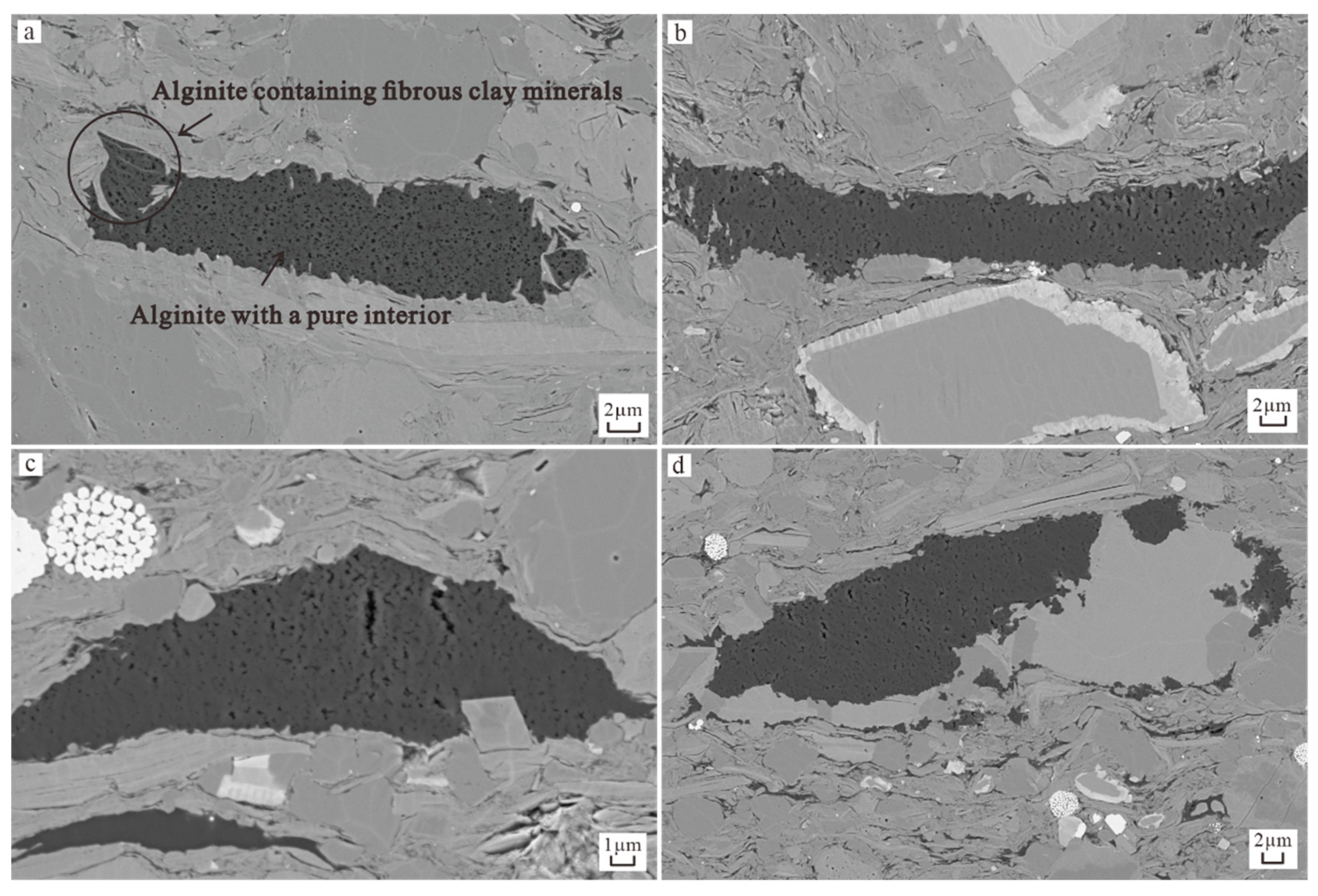
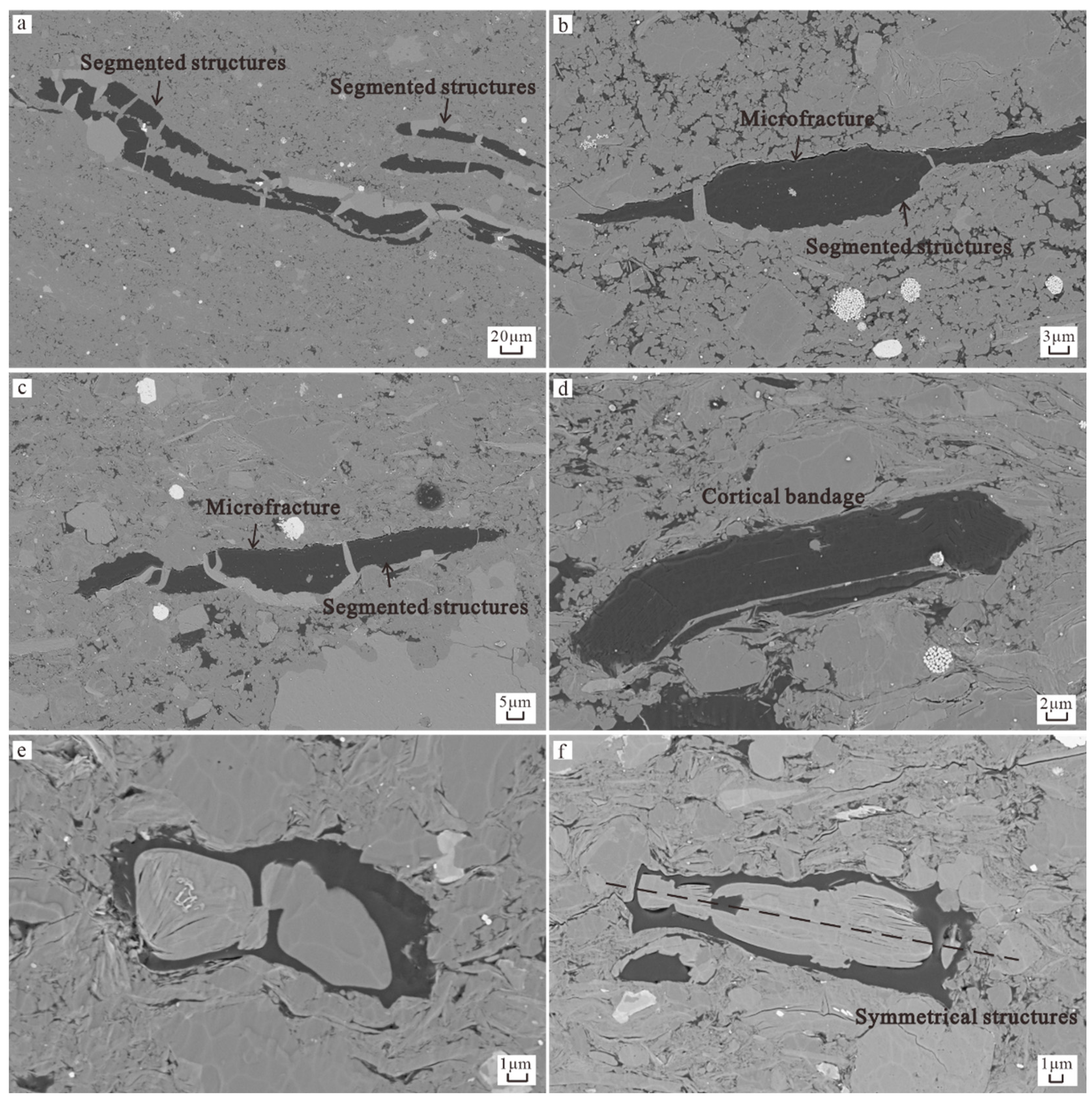
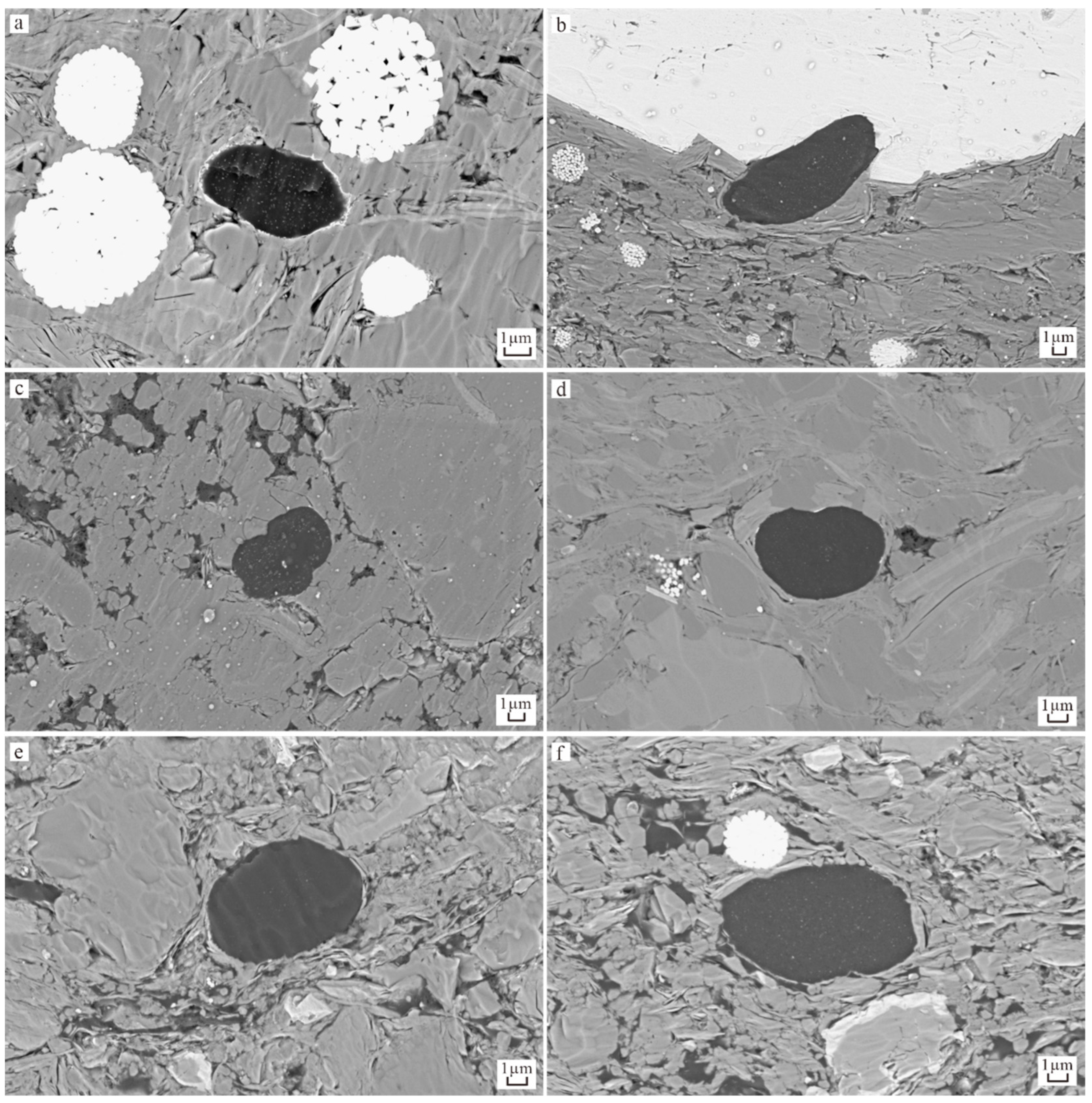
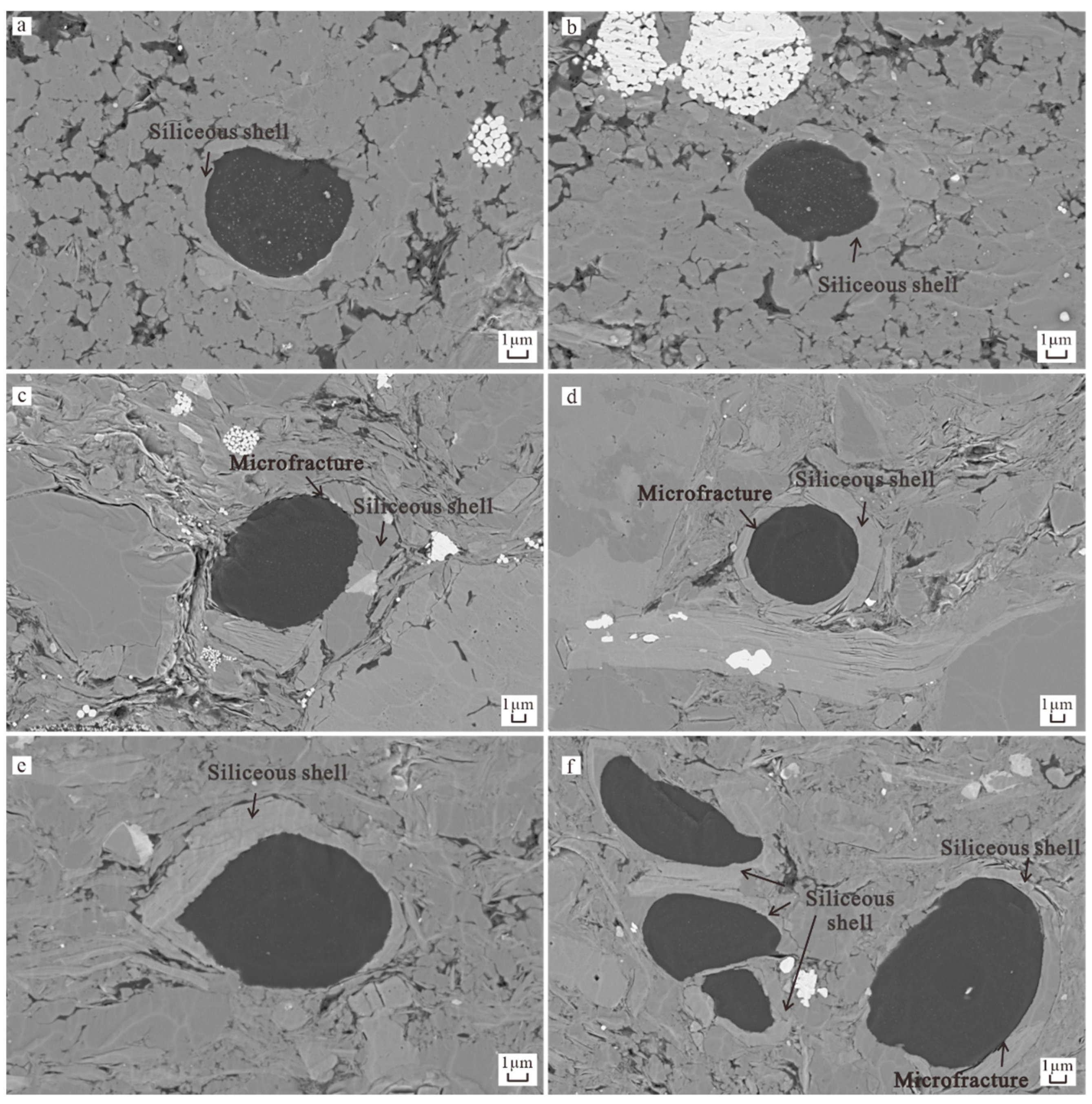

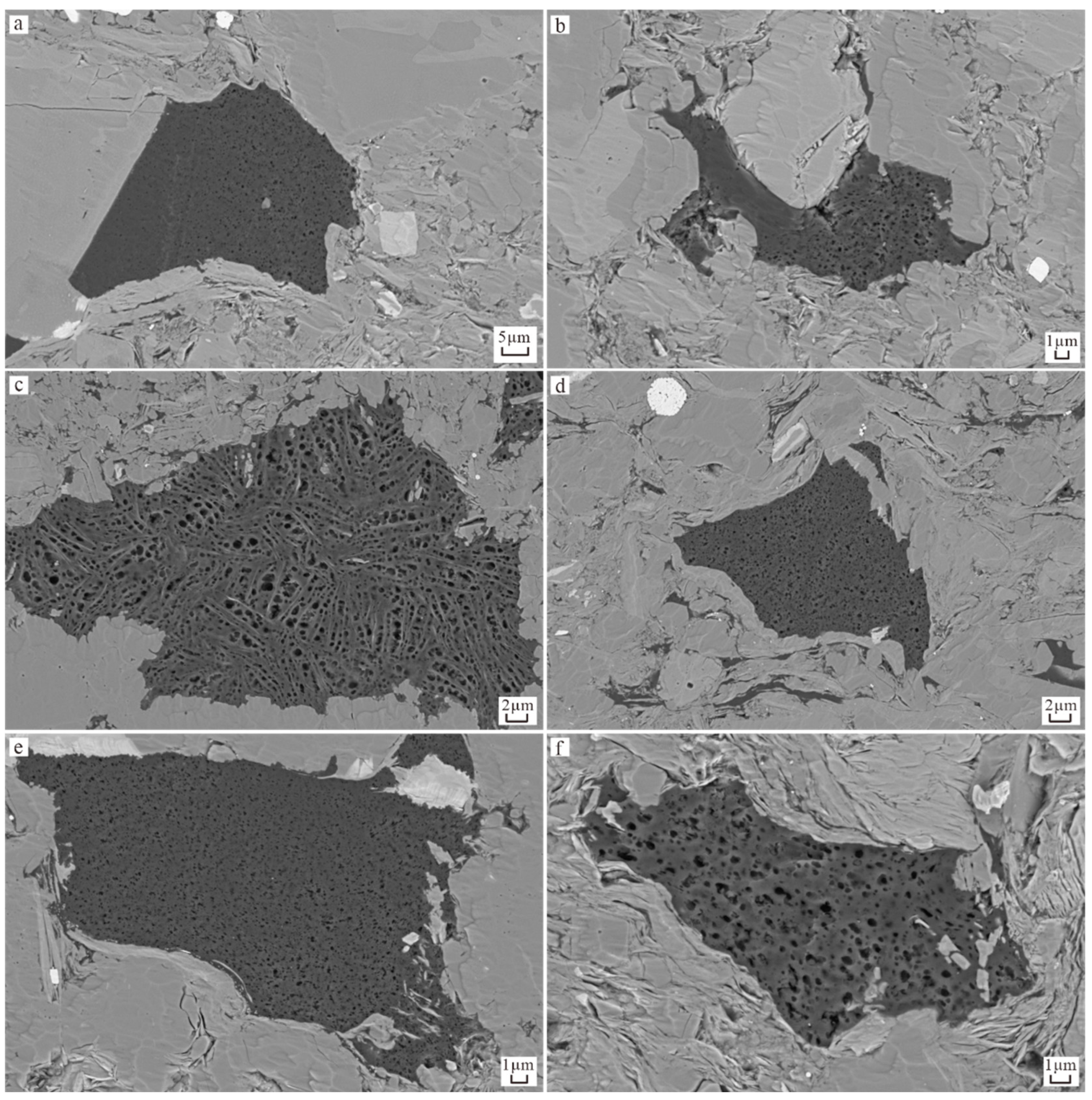
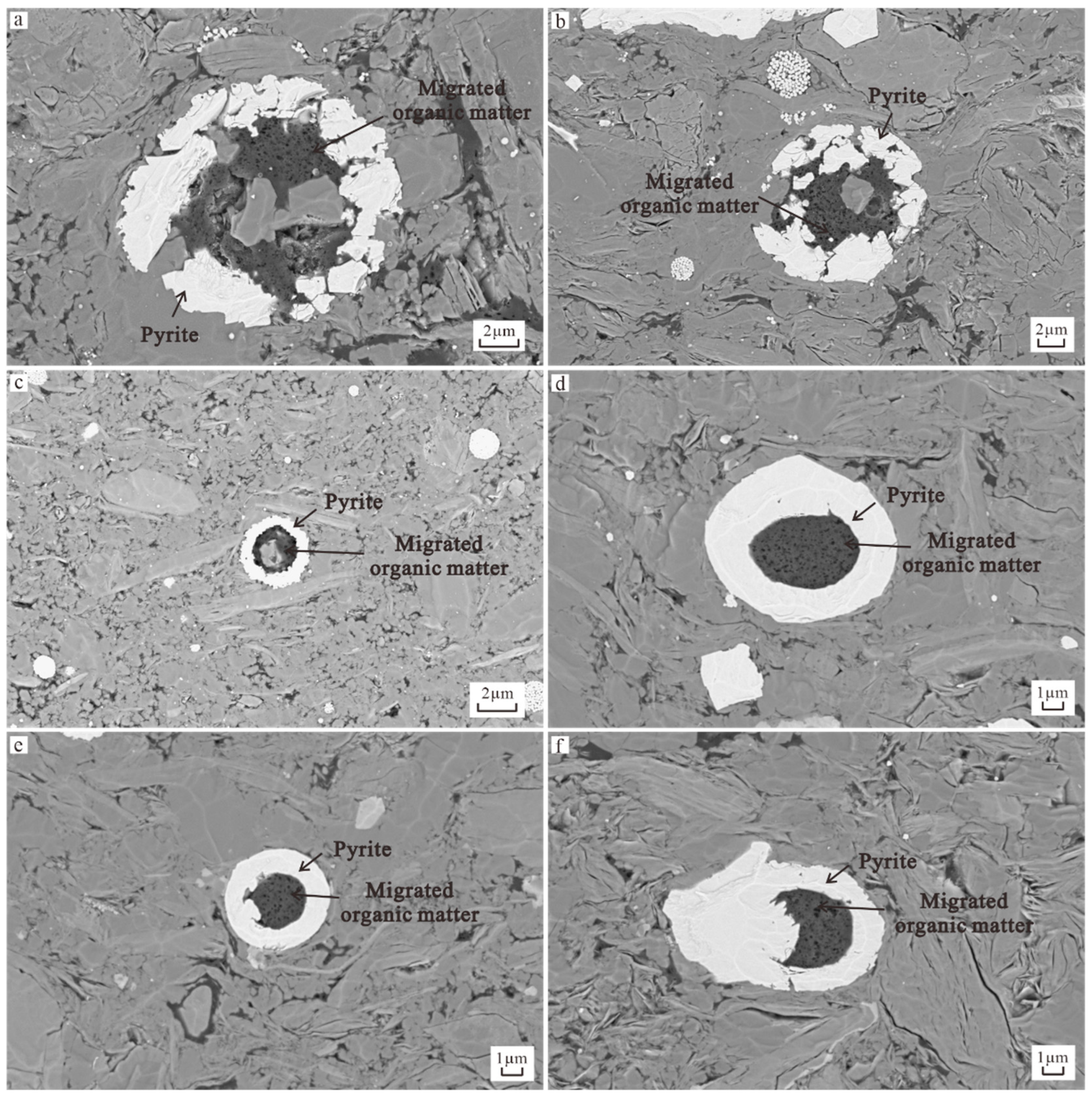
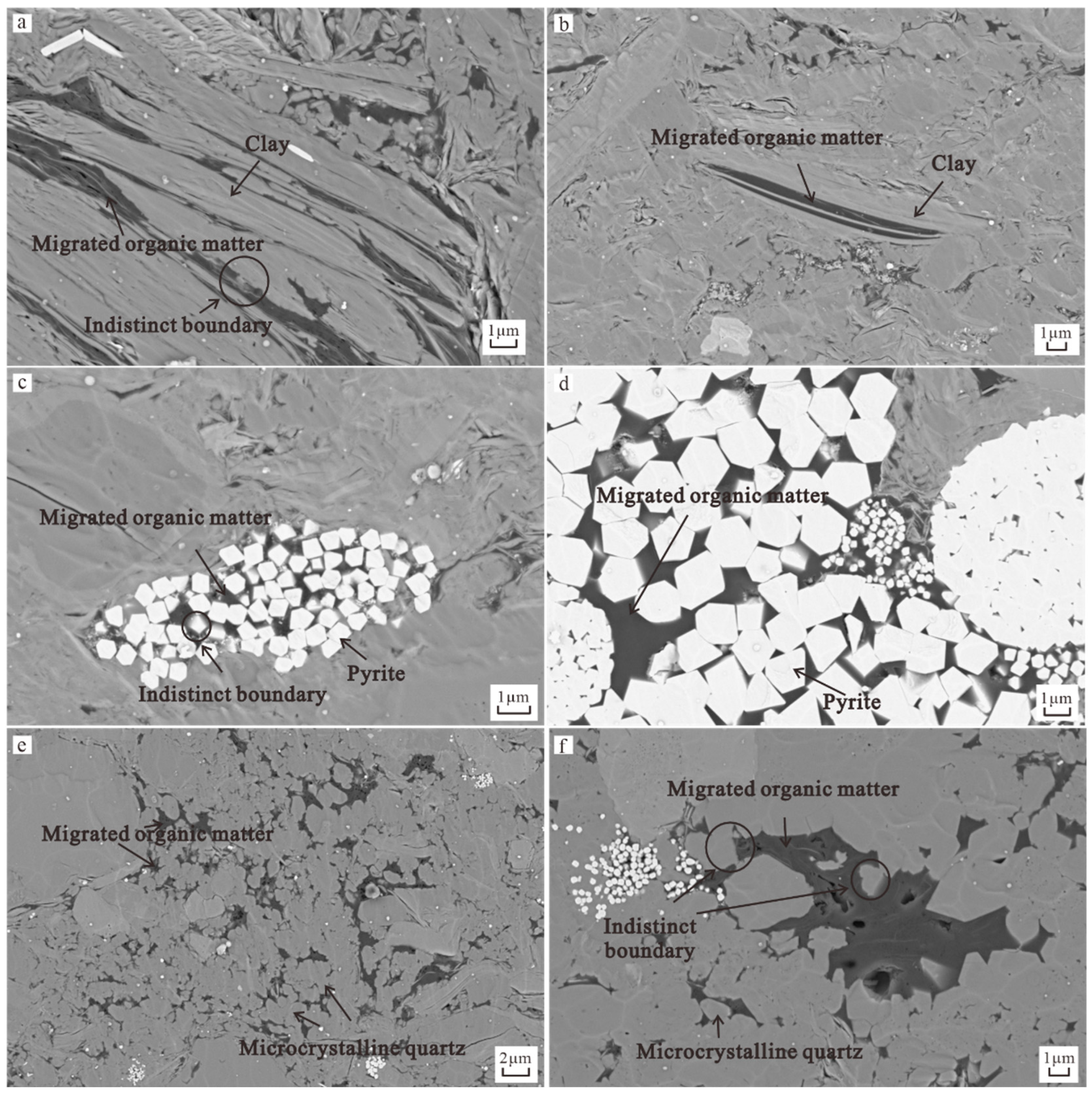
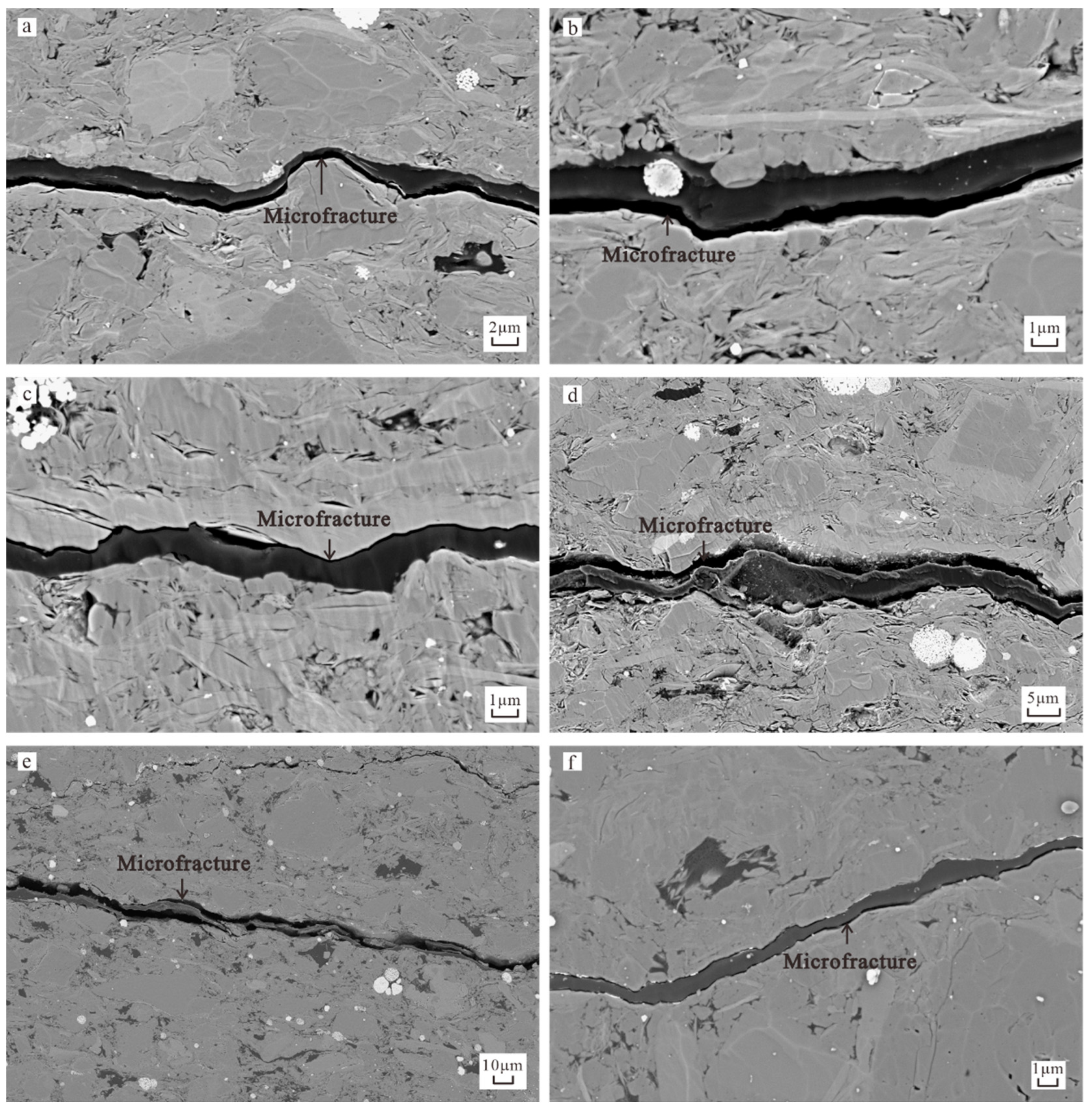

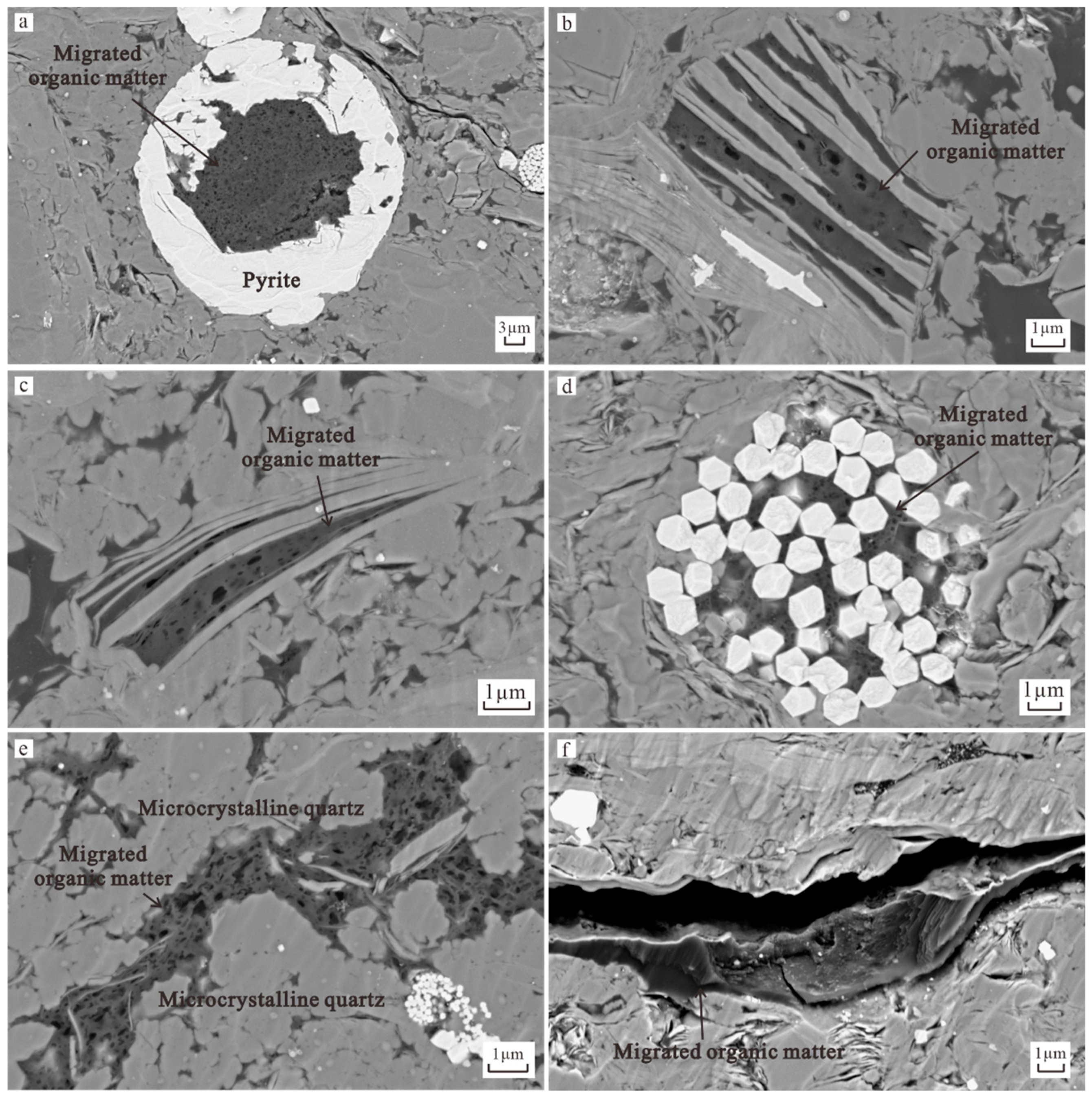
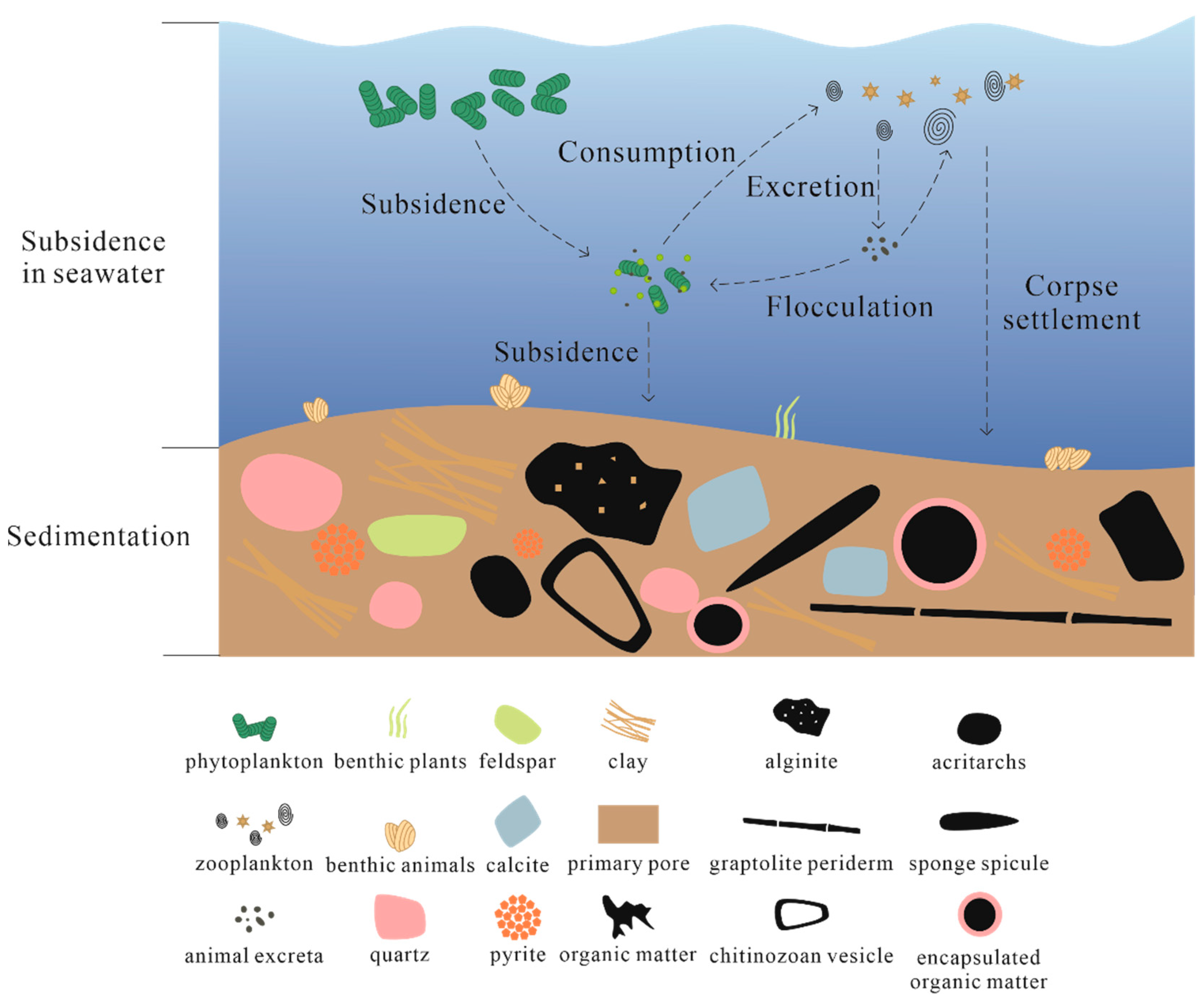
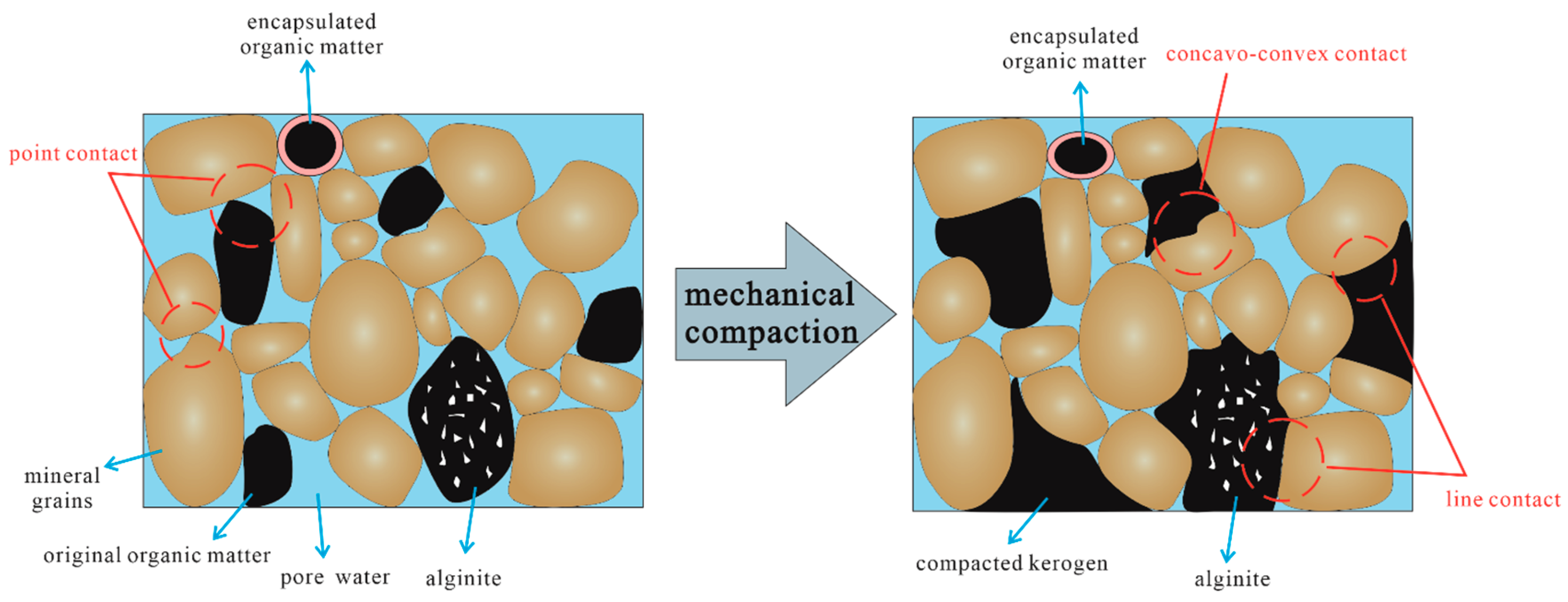
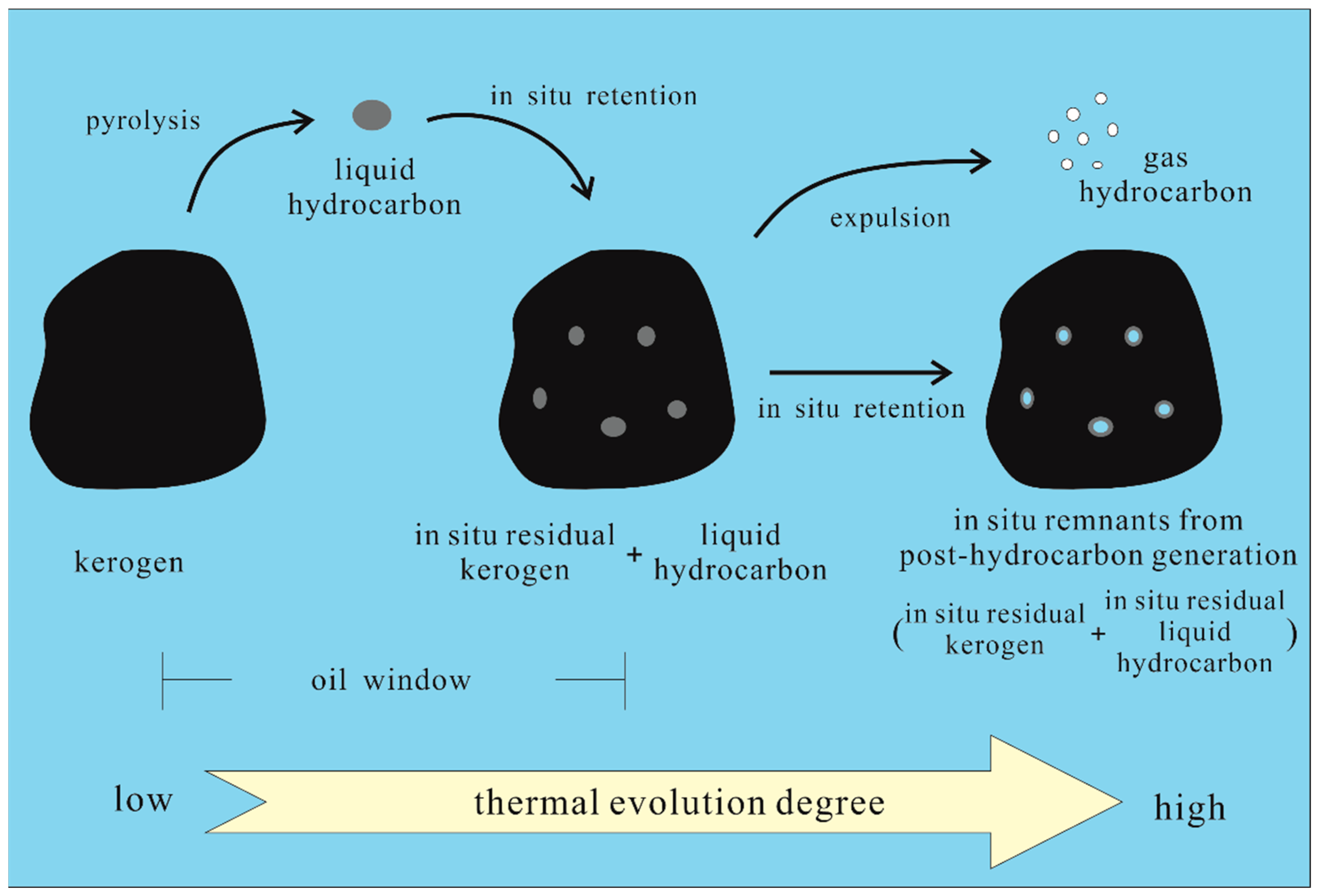
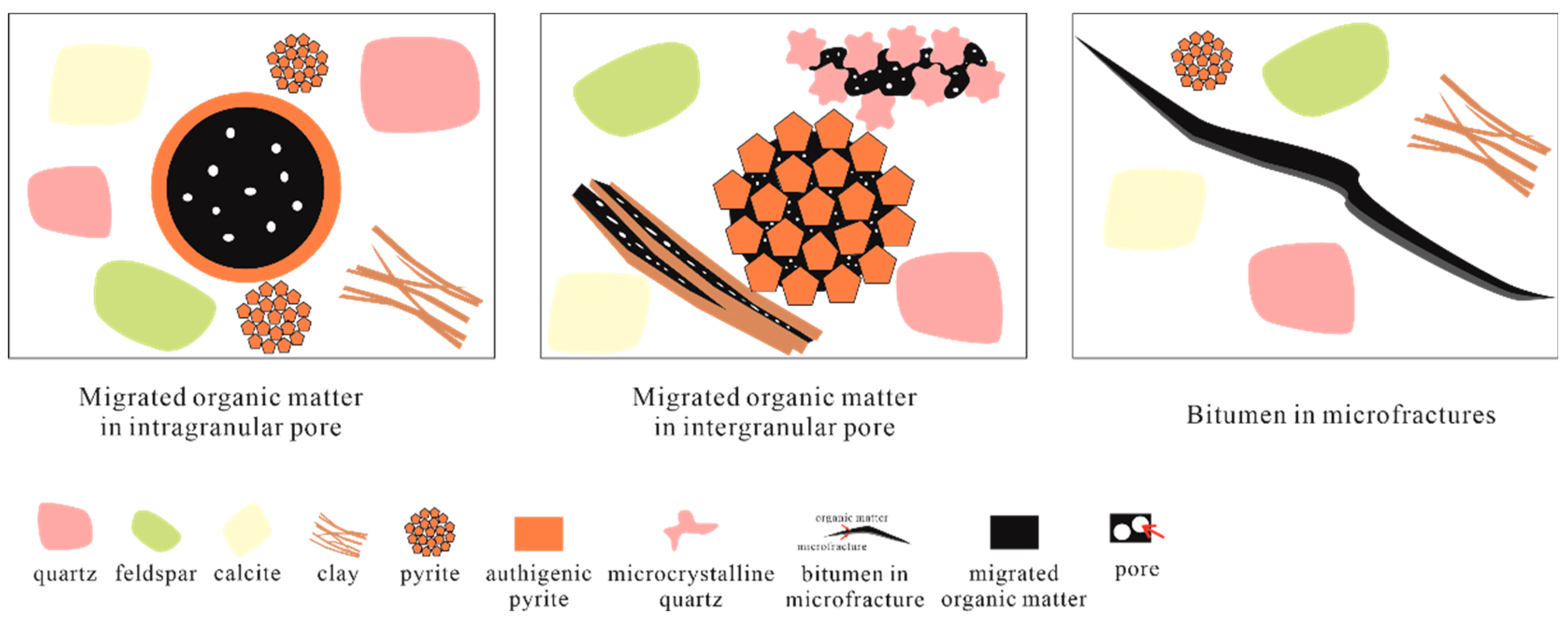
| Classification Criteria | Classification of Organic Matter | Characteristics |
|---|---|---|
| Maceral groups [12] | Vitrinite | Originating from higher plants, these particles are dispersed within shale matrices and generally lack cellular structure. |
| Inertinie | Originating from higher plants, these particles are dispersed within shale matrices and retain the cellular structure, including plant cell lumens. | |
| Liptinite | The highest concentration in shale occurs in fragmental forms, primarily consisting of alginite, bituminite, and liptodetrinite. Alginite is mainly derived from planktonic algae and is classified into telalginite and lamalginite. Bituminite originates from plankton, zooplankton, and bacteria that have undergone bacterial degradation, lacking a fixed structure. | |
| Zooclasts | Derived from fragments of planktonic or benthic organisms, distinguishable by their microscopic morphology. | |
| Secondary organic matter | Derived from fragments of planktonic or benthic organisms, distinguishable by their microscopic morphology. | |
| Mode of occurrence [28] | Banding organic matter | Appearing as straight or curved elongated strips or lenticular shapes, distributed parallel to the bedding, influenced by compaction and surrounding matrix minerals. |
| Agglomerate organic matter | Exhibiting irregular blocky shapes or regular round (or elliptical) forms, with distinct boundaries separating them from the matrix minerals, often oriented in a specific direction. | |
| Infilling organic matter | Filling clay-sized pores, bedding planes, or interlaminar fissures, serving as a cement for detrital grains, with indistinct boundaries between the organic matter and surrounding minerals. | |
| Interwrapped organic matter | Encapsulating or being encapsulated by authigenic minerals, with no fixed morphology. | |
| Distribution pattern [29] | Laminated organic matter | Includes two types: one characterized by interbedded organic-rich layers with mineral layers, and the other by elongated organic matter dispersed within a mineral matrix. |
| Particulate organic matter | Includes two types: one characterized by interbedded organic-rich layers with mineral layers, and the other by elongated organic matter dispersed within a mineral matrix. | |
| Transitional organic matter | The shape is irregular or constrained by surrounding minerals, with indistinct boundaries between the organic matter and the minerals. | |
| Genetic mechanism [26] | Depositional organic matter | The shape is irregular or constrained by surrounding minerals, with indistinct boundaries between the organic matter and the minerals. |
| Migrated organic matter | Petroleum and bitumen, along with their evolved derivatives, are formed through the thermal evolution of organic matter and migrate to adjacent pores/fractures. This process is characterized by the sequence where surrounding minerals form first, followed by the filling and injection of organic matter. | |
| Micromorphology [27] | Structural sedimentary organic matter | Exhibiting distinct structural morphology with clear boundaries separating it from the matrix minerals. |
| Differentiated syngenetic organic matter | Intergrown with clay minerals or authigenic quartz, forming a structure resembling a ’granitoid texture’, and distributed in a dispersed manner. | |
| Interstitially transported organic matter | Intergrown with clay minerals or authigenic quartz, forming a structure resembling a ’granitoid texture’, and distributed in a dispersed manner. |
| Criteria | Classification of Pores | Characteristics | |
|---|---|---|---|
| Genesis and occurrence location [40] | Organic matter pores | Pores are formed during the thermal cracking of organic matter to generate hydrocarbons, primarily developing between and within organic matter. | |
| Inorganic pores | Pores are formed during sedimentation or diagenesis through processes such as crystallization, cementation, and dissolution, and are distributed between or within mineral grains. | ||
| Microfractures | Including bedding-parallel fractures formed by sedimentation processes, and non-bedding-parallel fractures formed during diagenesis. Non-bedding-parallel fractures include hydrocarbon generation overpressure fractures, diagenetic shrinkage fractures, and dissolution fractures. | ||
| Formation stage [41] | Primary pores | Belonging to intergranular residual pores, controlled by compaction and cementation. | |
| Secondary pores | Pores formed through diagenetic modification based on primary pores, primarily controlled by dissolution processes. | ||
| Mixed pores | Including partial primary pores and partial secondary pores. | ||
| Percolation characteristics [36] | Total pores | The total sum of connected and non-connected pores within a reservoir, also referred to as absolute porosity. | |
| Connected pores | Super-capillary pores | Pore diameter > 500 μm. The liquid within the pores can flow freely under the influence of gravity. | |
| Capillary pores | Pore diameter from 0.2 μm to 500 μm. Fluid particles in the pores can only flow under the influence of driving pressure. | ||
| Microcapillary pores | Pore diameter < 0.2 μm. The liquid within the pores is immobile and exists in an adsorbed state. | ||
| Effective connected pores | The total of the reservoir’s ultra-micropores and micropores, also known as theoretical flow pores. | ||
| Flowing pores, and | The total of supra-capillary and capillary pores that can participate in fluid flow under reservoir production conditions, also referred to as production flow pores. | ||
| Charged pores | The sum of capillary and super-capillary pores that can participate in fluid flow under reservoir formation conditions, also referred to as charge flow pores. | ||
| Pore size [35] | Macropores | Pore diameter > 50 nm | |
| Mesopores | Pore diameter from 2 to 50 nm | ||
| Micropores | Pore diameter < 2 nm | ||
| Developmental morphology [42] | Zonal pores | The morphology is variable, constrained by the shape of organic matter particles, and is formed during hydrocarbons generation from the degradation of organic matter. | |
| Globular pores | At initial stage of pore formation resulting from the cracking of residual oil into gas. | ||
| Spongy pores | Forming through gas generation during pyrolysis at high evolution of the late diagenetic stage. | ||
| Degree of opening and Connectivity [37] | Open pores | Connected to the external environment | |
| Closed pores | Isolated from external connections | ||
| Type of Organic Matter | Morphology | Distribution Characteristics | Pore Development Characteristics | Genetic Mechanism | ||||
|---|---|---|---|---|---|---|---|---|
| Organic Matter | Organic Matter Pores | |||||||
| Depositional organic matter | Bioclasts | Alginite | irregular | Isolated granular distributed with a clear boundary with surrounding minerals. It is internally pure, with no clay minerals present, or less clay minerals exhibiting a fibrous distribution within the algal detritus. | The pores are well-developed, exhibiting irregular angular or rounded shapes, and are uniformly sized. The organic matter pore size between fibrous clay minerals ranges from approximately 10 to 50 nm, while the pore size within pure alginite ranges from several tens to several hundreds of nm. | Products of the diagenesis of planktonic algae. During the burial period, the formation fluids in some channels and fractures of the alginite react with rocks to form fibrous illite, resulting in alginite containing fibrous illite. | In low-mature organic matter, pores are often gaps between single-cell algae arrangements. Spherical pores result from the early stages of oil generation and the expulsion from algal-rich material. Pores that are regular in arrangement and have elongated, narrow, elliptical shapes may be attributed to compaction effects following hydrocarbon expulsion. | |
| Zooclasts | Graptolite periderm | banding or veining | It predominantly exists in the form of planar carbon films parallel to the bedding, with the cavities developing a segmented structure resulting in anisotropy. | The graptolite body exhibits either an absence or minimal development of pores, with occasional occurrences of localized nanoscale organic matter pores. Elongated nanoscale pores or microfractures are developed between the cortical fibrils. | Graptolite periderm is primarily composed of collagenous skeleton secreted by the conodont organism, typically preserved in black shale, which indicates a tranquil, anoxic, and stagnant reduction environment. | The biological tissue structure of conodonts reveals pores between cortical fibrils, with an increase in porosity corresponding to the evolution degree. | ||
| Chitinozoan vesicles | vase-shaped, conical, and cylindrical etc. | Some chitinous vesicles are connected in a chain-like manner, with most exhibiting a symmetrical structure. Shell cavities are often filled with inorganic minerals. | No pore | Individual microbial fossil. | / | |||
| Acritarchs | round or elliptical granules | Isolated and sporadically distributed, with close contact with surrounding minerals, clear boundaries, and visible apatite within the organic matter. | No pore | Derived from certain algae and unicellular organisms. | / | |||
| Encapsulated organic matter | spherical, ellipsoidal, or concentric structures | Isolated granular distributed with the development of siliceous shells. | No pore | The original organic matter is filled in siliceous shells primarily derived from radiolarians and sponges spicules. | / | |||
| Compacted kerogen | amorphous massive | Rigid mineral grains, such as quartz, are present in the surrounding environment, with no mineral cementation, allowing for direct contact between it and mineral grains. | Almost no pore | Under shallow burial or pressure, mineral particles are compressed and compacted, leading to plastic deformation of organic matter and subsequently the closure of adjacent pore spaces. | / | |||
| In situ remnants from post-hydrocarbon generation | amorphous massive | No crystal growth between it and adjacent minerals, with clear boundaries. The morphology includes granular and banded forms. | The pores are significantly developed, exhibiting round or elliptical shapes, resembling bubble-like or sponge-like structures. | Primary including the residual kerogen after the generation of oil and gas, and the in situ retained oil following the gas generation. | The formation of organic pores can be attributed to two primary mechanisms: first, during the pyrolysis of kerogen, a portion of the generated oil and gas is expelled from the source rock, resulting in the formation of pores; second, some in situ liquid hydrocarbons retained within the source rock undergo further thermal maturation through cracking, generating natural gas and consequently leading to the formation of organic pores. | |||
| Migrated organic matter | Migrated organic matter in intragranular pore | amorphous or constrained by mineral particles | Filling in the radiolarian siliceous shells replaced by pyrite, authigenic minerals are typically observed in the surrounding areas. | The pores are well-developed, exhibiting a vesicular morphology with irregular sizes and its diameters ranging from 30 to 300 nm. | Migrated organic matter is subsequently filled in these siliceous radiolarian shells replaced by pyrite, which forms concomitantly with bacterial sulfate reduction. | A significant amount of dry gas, generated from the secondary cracking of migrated organic matter, escapes from the organic matter, leading to the formation of organic matter pores. | ||
| Migrated organic matter in intergranular pore | amorphous | Filling in the intergranular pores of minerals with uneven size, the coexistence with authigenic minerals, and accumulation in the clay mineral flakes, pyrite crystals and microcrystalline quartz. | The pores are well-developed, with pores exhibiting a sponge-like structure and pore diameters generally ranging from 10 to 80 nm. | The organic matter that has migrated preferentially fills the pre-existing pores among mineral grains. | ||||
| Bitumen in microfractures | banding | In conformable contact with sedimentary clasts, It often interspersed with fragments of the surrounding rock or framboidal pyrite, with distinct boundary with matrix minerals. | Commonly, shrinkage cracks are well-developed, while pores are underdeveloped. | Organic-rich shale fractures along bedding planes under overburden pressure, forming microfractures, due to the lower cohesion and internal friction angle, increased porosity and reduced rock strength after hydrocarbon generation. The bitumen generated after the oil window migrates and fills these microfractures along their extension direction. | / | |||
Disclaimer/Publisher’s Note: The statements, opinions and data contained in all publications are solely those of the individual author(s) and contributor(s) and not of MDPI and/or the editor(s). MDPI and/or the editor(s) disclaim responsibility for any injury to people or property resulting from any ideas, methods, instructions or products referred to in the content. |
© 2025 by the authors. Licensee MDPI, Basel, Switzerland. This article is an open access article distributed under the terms and conditions of the Creative Commons Attribution (CC BY) license (https://creativecommons.org/licenses/by/4.0/).
Share and Cite
Zhao, M.; Wang, H.; Shi, Z.; Zhao, Q.; Zhou, T.; Qi, L. Microscopic Characteristics and Formation of Various Types of Organic Matter in High-Overmature Marine Shale via SEM. Appl. Sci. 2025, 15, 1310. https://doi.org/10.3390/app15031310
Zhao M, Wang H, Shi Z, Zhao Q, Zhou T, Qi L. Microscopic Characteristics and Formation of Various Types of Organic Matter in High-Overmature Marine Shale via SEM. Applied Sciences. 2025; 15(3):1310. https://doi.org/10.3390/app15031310
Chicago/Turabian StyleZhao, Meng, Hongyan Wang, Zhensheng Shi, Qun Zhao, Tianqi Zhou, and Ling Qi. 2025. "Microscopic Characteristics and Formation of Various Types of Organic Matter in High-Overmature Marine Shale via SEM" Applied Sciences 15, no. 3: 1310. https://doi.org/10.3390/app15031310
APA StyleZhao, M., Wang, H., Shi, Z., Zhao, Q., Zhou, T., & Qi, L. (2025). Microscopic Characteristics and Formation of Various Types of Organic Matter in High-Overmature Marine Shale via SEM. Applied Sciences, 15(3), 1310. https://doi.org/10.3390/app15031310








